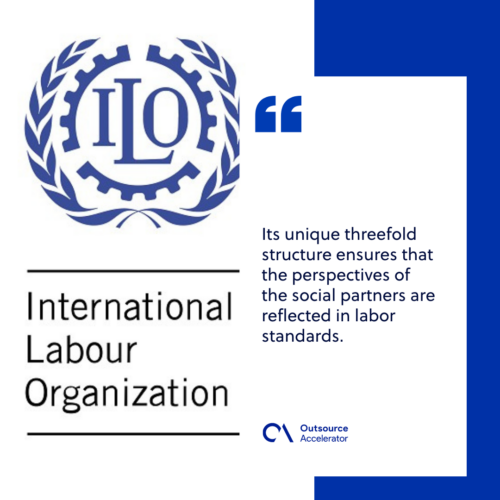International Labour Organization (ILO)
Definition
What is the International Labour Organization?
Through the Treaty of Versailles signed in 1919, International Labour Organization (ILO) was founded by the League of Nations in the same year. Decades later, it became a United Nations specialized agency in 1946.
The ILO is the United Nations’ first and oldest technical organization.
What is the essence of the International Labour Organization?
Workers’ rights, proper job possibilities, social protection, and fostering dialogue on work-related issues are all top priorities for the ILO.
Its unique threefold structure ensures that the perspectives of the social partners are reflected in labor standards. It also includes the formulation of policies and programs, giving workers, employers, and governments an equal voice.

Who are the members of the international labor organization?
187 countries are members of the ILO. The ILO comprises 186 of the United Nations’ 193 member states, plus the Cook Islands.
Among the UN member nations, Andorra, Bhutan, Liechtenstein, Micronesia, Monaco, Nauru, and North Korea are not members of the ILO.
4 fundamental rights set out by the International Labour Organization
Here are the four fundamental rights declared by the ILO:
1. Freedom of association and the effective recognition of the right to collective bargaining
These fundamental rights allow for the promotion and realization of decent working conditions.
Workers’ and employers’ organizations that are strong and autonomous and the successful recognition of their right to engage in collective bargaining are essential tools for labor market governance.
Collective bargaining is a method of achieving mutually beneficial and constructive solutions to potentially conflictual worker-employer relationships. It allows the parties to foster trust via negotiation and the expression and fulfillment of the various interests of the negotiating partners.
It promotes representative labor and management organizations to participate peacefully, inclusively, and democratically.
2. The elimination of forced or compulsory labor
There are over 20 million people subjected to forced labor globally, and women and children are not spared from it. It usually comes in the form of slavery, human trafficking, or bonded labor.
Victims of forced labor experience food deprivation, physical harm, sexual abuse, or illegal detention.
3. The abolition of child labor
The effective eradication of child labor ensures that every child has the chance to attain their full physical and mental development.
ILO’s goal is to end all child labor that jeopardizes their education or development. It does not imply that all children’s work should be stopped. International labor standards enable children of various ages and stages of development to distinguish between what constitutes acceptable and inappropriate forms of work.
4. The elimination of discrimination in respect of employment or occupation
The first step toward eliminating work discrimination requires breaking down obstacles and promoting equal access to education and other resources for development.
This ILO is focused on policies and practices relating to recruitment, task assignment, working conditions, compensation, and benefits. It also encompasses the promotions, layoffs, and termination of employment policies and practices.







 Independent
Independent




